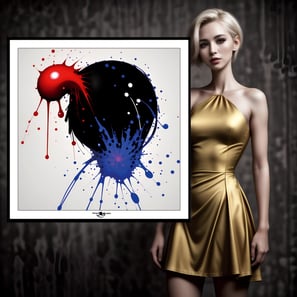Detailed Guide for Digital Art Prints
Dear customer, in this guide you will find the necessary information to print your purchased illustrations with the best quality
Buying digital art offers incredible flexibility in terms of printing and customization. To ensure you achieve the best results when printing your digital artworks, it's crucial to understand the recommended file sizes, printing technologies, paper and canvas types, and protective measures to preserve colors. Below is a comprehensive guide to assist you in this process.
Recommended File Sizes for Printing
Reference size of framed 30 cm x 30 cm (12 in x 12 in) artwork
Printing Technologies
Resolutions available in our store go up to 50x50cm. For larger or customized sizes, please contact us using the contact form.
Giclée Printing:
Laser Printing:
UV Printing:
This is one of the most popular techniques for high-quality art printing. It uses inkjet printers with pigment-based inks that offer high color fidelity and durability.
Utilizes toner instead of liquid ink. It's suitable for quick, high-volume prints, though it may not always match the color quality of giclée printing.
Uses inks that cure instantly under ultraviolet light, allowing for printing on a variety of surfaces, including rigid materials.
Types of Paper and Canvas
The type of paper or canvas used can greatly influence the final print quality. Here are some popular options:
Glossy Photo Paper:
Matte Photo Paper:
Fine Art Paper:
Ideal for vibrant colors and sharp details. Perfect for photos and digital art requiring a shiny finish.
Offers a non-reflective finish, ideal for prints with softer tones and for pieces displayed under bright lights.
Such as Hahnemühle Photo Rag, which is a high-quality matte paper, ideal for high-end art prints.
Canvas:
Provides a textured finish that emulates traditional paintings. It's an excellent choice for large-scale works and those seeking an artistic and durable finish.
Protective Measures to Preserve Colors
To ensure your prints maintain their quality over time, consider the following protective measures:
UV Protection Glass:
If framing your artwork, use UV-protected glass to prevent colors from fading due to sunlight exposure.
Protective Spray Sealers:
Applying a specific spray sealer for art can add a protective layer against dust, moisture, and UV rays.
Professional Framing:
Use high-quality, acid-free materials for framing to prevent the colors from degrading over time.
Proper Storage:
If you do not plan to frame immediately, store your prints in a dark, dry place, preferably in acid-free archival folders.
Conclusion
Printing digital art is a fantastic way to personalize and enjoy your pieces in a tangible form. By following these recommendations regarding file sizes, printing technologies, paper and canvas types, and additional protective measures, you can ensure that your prints are of the highest quality and longevity. For more detailed and personalized information regarding the purchased illustrations and the process for printing them on physical media, please feel free to contact us using the contact form. We're here to help!






The resolution of the image file is fundamental to obtaining high-quality prints. Here is a table with the recommended file sizes based on the desired print size in both centimeters and inches:
Reference size of framed 50 cm x 50 cm (20 in x 20 in) artwork
Reference size of framed 70 cm x 70 cm (28 in x 28 in) artwork
Several printing technologies can be considered for your digital artworks:
